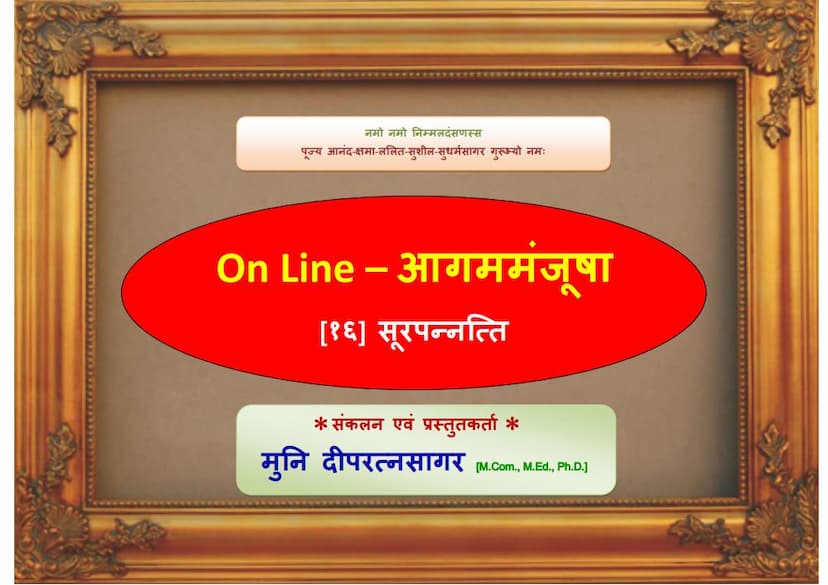Aagam Manjusha 16 Uvangsuttam Mool 05 Sooyapannatti
Added to library: September 1, 2025

Summary
Here's a comprehensive summary of the provided Jain text, "Aagam Manjusha 16 Uvangsuttam Mool 05 Sooyapannatti," focusing on its astronomical and cosmological content as presented:
The text, "Sooyapannatti" (Surya Prajnapti), is an ancient Jain scripture that meticulously details the movements, characteristics, and influences of celestial bodies, primarily the Sun, Moon, and stars, within the Jain cosmology. The work aims to provide a systematic understanding of the celestial realm, its cycles, and their relationship to time and human experience.
Key Themes and Content:
-
Celestial Mechanics and Cycles:
- Sun's Movement: The text elaborates on the Sun's intricate path through various celestial circles (mandala), describing how it moves from inner to outer circles and vice versa. It quantifies the duration of days and nights based on these movements, explaining the variations throughout the year.
- Lunar Cycles: Similar to the Sun, the Moon's movements and phases are analyzed, detailing its journey and its interaction with the solar system.
- Conjunctions and Aspects: The text discusses the conjunctions (yoga) of the Moon and stars, as well as the Sun and stars, specifying the exact durations and patterns of these celestial alignments. It categorizes stars based on their relationships with the Moon and Sun, outlining how many stars are associated with specific lunar or solar phases.
- Yearly Cycles: The work outlines the structure of the year, dividing it into months, seasons (like Hemanta and Grishma), and their respective characteristics. It details the duration and progression of these periods, influenced by celestial movements.
- Celestial Luminosity and Reach: The text specifies the extent to which the Sun and Moon illuminate and influence different regions of the cosmos, including various islands (dweepa) and oceans.
-
Cosmological Structure and Geography:
- Mount Meru and Celestial Spheres: The text references Mount Meru, a central cosmic mountain in Jainism, and its role in celestial observations. It describes the Sun's movement in relation to Meru and the surrounding celestial spheres.
- Celestial Regions: The scripture defines different celestial regions and their compositions, including the celestial chariots (viman) of the Sun, Moon, planets, and stars, detailing their size, shape, and the deities residing within them.
- Planetary and Stellar Families: It describes the vast retinues of deities associated with each celestial body, including the attendants of the Sun, Moon, planets, and stars, specifying their numbers and hierarchical structure.
-
Timekeeping and Astronomical Calculations:
- Units of Time: The text defines and utilizes various units of time, including muhurta (a period of 48 minutes), ahoratra (a day-night cycle), paksha (fortnight), masa (month), ritu (season), ayana (six-month period), samvatsara (year), and yuga (a larger time cycle).
- Calculating Celestial Positions: It provides methods for calculating the positions and movements of celestial bodies based on specific lunar and solar days, muhurtas, and the relative positions of stars.
- Nakshtras (Lunar Mansions): A significant portion of the text is dedicated to the 27 nakshtras, detailing their individual characteristics, names, classifications (based on their association with the Moon and Sun), the deities presiding over them, their governing clans (gotra), and their specific alignments during different lunar phases and seasons.
- Shadows and Projections: The text analyzes the shadows cast by celestial bodies, describing how the length and direction of shadows change based on the Sun's position and the time of day, relating this to concepts of time measurement.
-
Specific Celestial Bodies and Phenomena:
- Rahu: The text discusses the celestial being Rahu, explaining its role in eclipses, differentiating between permanent and transient Rahu. It describes Rahu's luminosity and its influence on human perception of celestial events.
- Eclipses: While not explicitly detailed in the provided excerpt, the concept of Rahu's interaction with the Sun and Moon implies the occurrence of eclipses, a natural consequence of celestial movements.
- Celestial Luminosity: The scripture addresses how celestial bodies emit light and influence visibility, with detailed descriptions of the Sun and Moon's brilliance and coverage.
-
Classification and Categorization:
- The text exhibits a highly systematic approach, classifying celestial bodies, their movements, and their associated phenomena into various categories and sub-categories. This systematic approach is evident in the detailed discussions of nakshtras, planetary families, and time units.
Methodology and Presentation:
- Scholarly and Detailed: The "Sooyapannatti" is characterized by its precise and detailed descriptions, often involving complex calculations and specific measurements in terms of yojanas (a unit of distance), muhurtas, and divisions of time.
- Question-and-Answer Format (Implied): The structure suggests a dialogue or discourse where questions about celestial phenomena are posed and then answered with detailed explanations.
- Emphasis on Observation and Calculation: The text implies a deep understanding of astronomical observation and mathematical calculation for its time.
In essence, the "Sooyapannatti" serves as a foundational text for understanding Jain astronomy and its intricate workings. It reflects a sophisticated attempt to map and comprehend the celestial movements and their temporal and spatial implications within the Jain worldview. The detailed classifications and calculations highlight the Jain emphasis on precise knowledge and its application in understanding the universe.